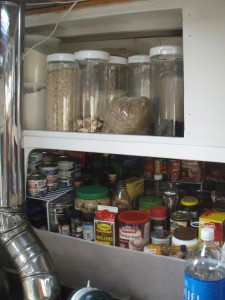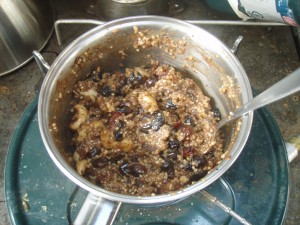One of the biggest challenges to moving onboard has been feeding myself. I’m no fan of junk food, but more days than I care to admit I find myself rowing to shore and biking up to Cambie and Broadway for a slice of pizza instead of trying to sort out some sort of decent home-cooked meal.
So why is it such a challenge? Well for one, I don’t technically have a refrigerator. I do have an icebox about the size of a bar fridge, and I can purchase a block of ice for $2 nearby – but the irregularity of the ice supply at the store, combined with my slackful demeanor and busy social calendar, adds up to a box that isn’t often cold. There’s ways around this of course, and longer-term I hope to install a small fridge – though that will have to come well after I replace the electrical system, as it currently barely supports the power drain of my running lights, much less an always-on, power-hungry appliance!
I have also been cooking pretty much exclusively on a single-burner Coleman propane camping stove. I do have a large diesel stove with an oven, but it takes a good fifteen minutes to get started and heated up, and being a proper stove it heats the cabin very effectively – I will certainly be using the stove in the winter, but for summertime it’s proven to be much quicker (and far more comfortable!) to just light the small propane burner to make my coffee. One unexpected side-effect of cooking over fire: I’ve had to replace all of my cheap non-stick cookware with stainless steel. I was hesitant to do this until I figured out that cleaning steel pots is trivial if you use steel scouring pads; now I want everything to be steel!

Food-wise I’ve taken a lot of inspiration from memories of my friend Jake’s farmhouse as a kid; specifically the large family pantry with big glass jars filled with dried fruit, rice, flour, pastas and other dry goods. I’ve populated my pantry with foods that can last a long time, or foods that could feasibly withstand a soaking in saltwater should something terrible occur, like canned goods. I’ve purchased many large, airtight plastic containers, and have begun buying most of my basic foodstuffs in bulk. I’ve actually really been enjoying the return to more ‘traditional’ kitchen values, and I know I’m not alone in this; several times this fall I’ve been gifted with preserves packaged by friends, from foods they’ve grown in their gardens or prepared from scratch.
Despite the challenges I’ve found many workarounds, and while I’m still not very good at cooking lunch or dinner, I feel I’ve honed my breakfast-making skills to a keen edge. My two best dishes are apple-blueberry buckwheat pancakes – usually reserved for days when I have a guest for breakfast – and oatmeal.
I’ve been cooking oatmeal for myself for a while now, pretty much since moving aboard. My old ‘default’ breakfast was a high-protein, low-carb frittata; a handful of spinach, a dollop of fresh salsa and a cup of liquid egg whites, microwaved for three minutes on high and served with a dash of hot sauce. I loved this breakfast, but the real benefit (ie. speed of preparation) is lost when you don’t have a microwave. “Quick” oats are fast and easy and tasty and filling, but it wasn’t until I switched over to steel-cut oats that my oatmeal breakfast really got going.
So without further ado, here is my recipe for a wholesome, healthy breakfast without the use of a refrigerator:
In a stainless steel saucepot, combine:
- one small handful(*) of steel-cut oats
- one small handful of quinoa
- one small handful of raisins
- one small handful of dried cranberries
- one small handful of dried blueberries
- one small handful of dried cherries
- one small handful of mixed almonds and cashews
- one midsize handful of ground flax seed
- several shakes from a shaker of ground cinnamon
- a pinch of salt
- a cup and a half or so of water – as much as you think should be in there, then another half-cup for good measure
Cooking instructions: put the pot on a Coleman propane burner, stirring occasionally, and boil until it looks like oatmeal. Usually takes ten to fifteen minutes to complete.
(*: American readers, I’m referring to a metric handful, not an imperial handful.)

The real glory of this recipe is the quinoa – I have become a huge fan of this grain! When I was cooking with regular or “quick” oats, the oatmeal would be finished cooking within a few minutes, nowhere near long enough for quinoa to properly cook. Since the steel-cut oats take ten to fifteen minutes, there’s enough time for the quinoa, which adds a huge amount of nutrients and makes this pretty much a perfect meal. Bonus: the longer cooking time stews the dried fruit, extracting the flavour into the oatmeal.
As a final bonus, serve the oatmeal with a liberal drizzling of molasses. I’ve been using molasses for pretty much all my sweetening needs, be it breakfast, coffee, or a snack with peanut butter and soft, fresh bread – and to top it off, check out the label on the side of the molasses container: DO NOT REFRIGERATE. Sweet.
Damn, now I’m hungry again.
Do you have on-board propane? Don’t forget those RV style fridges are DC, AC and propane. I don’t think it even requires a chimney or anything, something worth looking into if you really want a fridge and aren’t using propane for anything else.
PropaneFridge++
I have a tri-source fridge/freezer in the camper… ac, dc and propane. It’s great. A month of full time (including cooking) on two bbq sized propane canisters. The freezer is also cold. It should work very well, if you have propane on board.
The trick with the RV style fridges is that if they get tipped too much, they can burn out the evaporator coil, which is an expensive repair. I’m sure there must be marine versions designed to be more resilient, but that’s something to watch for.
I hadn’t really considered a propane stove – propane on a boat has its own set of downfalls that you don’t see on an RV or a camper. Think about it – propane is heavier than air, and the bottom of a boat is a big airtight bucket, basically. If you have a propane leak, you have to VERY CAREFULLY empty the boat of propane by bucket brigade, using plastic buckets; the slightest spark could blow the boat apart. Even a tiny leak can add up, because there’s no place for the propane to dissipate!
…that being said, I’ve been using the little one-burner stove, and it’s remarkably handy. I’ve been using the little green disposable propane tanks, and only going through one ever two or three weeks.
Still, I think I’d like to go 12V DC and avoid using larger propane tanks if possible. I have tonnes of space on the cabin roof for large photovoltaic panels, and my friend Chris works at Xantrex and is going to help me hammer out the redesign of the electrical system…
Fortunately(?) it’s coming up fast on wintertime, and the problem is moot for now – the icebox bottom wall is technically below the waterline and that wall isn’t insulated, so for the next few months the icebox will stay quite cool on its own.